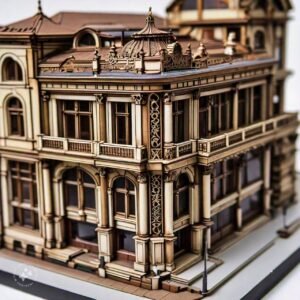BLOG
The 1968 McLaren M8A 1/43 Scale Model: A Detailed Look at Rearview Mirrors

The world of scale modeling is a fascinating realm that allows enthusiasts to recreate iconic vehicles with incredible attention to detail. One such vehicle that has captured the imagination of collectors and modelers alike is the 1968 McLaren M8A, a legendary race car that made its mark in the world of motorsports. This blog post will delve into the significance of the M8A, particularly focusing on the rearview mirrors in the 1/43 scale model, exploring their design, importance, and how they contribute to the overall authenticity of the model.
The Legacy of the McLaren M8A
Before we dive into the details of the rearview mirrors, let’s take a moment to appreciate the history and significance of the McLaren M8A.
A Brief History
The McLaren M8A was designed by the renowned engineer Bruce McLaren and was introduced in 1968 for the Can-Am racing series. This car marked a turning point in McLaren’s racing efforts, as it was one of the first cars to take full advantage of the regulations that allowed for an open design and powerful engines.
Key Features of the McLaren M8A:
Engine: The M8A was powered by a Chevrolet V8 engine, which was capable of producing over 600 horsepower, making it one of the most powerful racing cars of its time.
Design: With its sleek aerodynamic shape and lightweight chassis, the M8A excelled on the racetrack, showcasing the innovative engineering that McLaren was known for.
Success: The M8A achieved significant success in the Can-Am series, with drivers like Bruce McLaren and Denny Hulme piloting it to numerous victories, further solidifying McLaren’s reputation in motorsport.
The Importance of Scale Models

Scale models like the 1/43 McLaren M8A serve several purposes for collectors and enthusiasts:
1. Historical Preservation: Scale models allow fans of automotive history to preserve and appreciate classic vehicles that may no longer exist in their original form.
2. Detailing and Craftsmanship: Building and collecting scale models require a keen eye for detail, and the craftsmanship involved in creating these miniatures is a testament to the skill of model makers.
3. Educational Value: Scale models provide an educational opportunity for enthusiasts to learn about the design, engineering, and history of vehicles in a tangible way.
4. Display and Aesthetic Appeal: Scale models are often beautifully crafted, making them perfect for display in homes or offices, showcasing the artistry of automotive design.
Exploring the 1/43 Scale Model of the McLaren M8A
Now that we’ve established the significance of the McLaren M8A, let’s take a closer look at the specific features of the 1/43 scale model, with a focus on the rearview mirrors.
Understanding Scale Models
The 1/43 scale means that the model is 43 times smaller than the actual vehicle. For example, if the real McLaren M8A measures about 4.5 meters in length, the model will be approximately 10.5 centimeters long. This scale is popular among collectors due to its manageable size while still allowing for intricate detailing.
The Role of Rearview Mirrors
In any automotive design, rearview mirrors play a crucial role in safety and functionality. They provide drivers with visibility of the road behind them, allowing for safe lane changes and awareness of approaching vehicles. In the context of the McLaren M8A, rearview mirrors also contribute to the car’s aesthetics and aerodynamic profile.
Design and Detailing of the Rearview Mirrors in the Model
When it comes to scale models, attention to detail is key. The rearview mirrors on the 1/43 McLaren M8A model are designed to closely resemble those on the original car, showcasing the following characteristics:
1. Material Quality
The mirrors in the model are typically made from high-quality plastic or resin, which allows for detailed molding and finishing. Some high-end models may even use metal for a more realistic appearance.
2. Mirror Shape and Size
The shape and size of the mirrors are crucial for capturing the essence of the M8A. The rearview mirrors on the model are proportionate and designed to mimic the sleek lines of the actual car, adding to its aerodynamic profile.
3. Finishing Touches
Attention to finishing touches is what separates a good scale model from a great one. The mirrors are often painted or finished with a reflective surface to simulate glass. This detail enhances realism, making the model more visually appealing.
4. Mounting and Positioning
The mirrors are accurately positioned on the car, typically mounted on the sides of the cockpit. Proper alignment is essential to replicate the original vehicle’s design, ensuring that the mirrors are not only functional in the model but also contribute to its overall aesthetics.
Comparison with Other Scale Models
The rearview mirrors of the 1/43 McLaren M8A can be compared to those on other scale models in terms of design and detailing. For instance, let’s look at how mirrors on other race cars are designed in this scale:
Ferrari 312: Known for its distinctive and bold mirrors, the Ferrari 312 features larger rearview mirrors designed for maximum visibility, reflecting the racing culture of the time.
Lotus 49: The Lotus 49 model incorporates small, aerodynamic mirrors that align with its sleek design, focusing on performance and aerodynamics.
The differences in mirror design among these models reflect the unique characteristics of each car, showing how specific details like rearview mirrors can capture the essence of a vehicle’s design philosophy.
The Importance of Rearview Mirrors in Scale Modeling
The inclusion of detailed rearview mirrors in a scale model is not merely a cosmetic feature; it serves several important purposes:
1. Enhancing Realism
Realistic rearview mirrors contribute to the overall authenticity of the model. Collectors appreciate models that look and feel true to life, and intricate details help achieve this goal.
2. Improving Aesthetic Appeal
A well-designed rearview mirror can enhance the visual appeal of the model. It draws the viewer’s eye and adds depth to the overall presentation of the vehicle.
3. Encouraging Collectibility
Models that incorporate accurate and high-quality details, including rearview mirrors, are often more sought after by collectors. A model that showcases attention to detail is more likely to become a centerpiece in a collection.
4. Educational Opportunities
For those interested in automotive design and engineering, understanding the purpose and design of rearview mirrors can provide valuable insights into the considerations that go into car design.
Care and Maintenance of Your 1/43 Scale Model
Once you’ve acquired a 1/43 scale model of the McLaren M8A, it’s essential to care for it properly to maintain its condition. Here are some tips for keeping your model in top shape:
1. Regular Dusting
Dust can accumulate on models, obscuring details like rearview mirrors. Use a soft, dry cloth or a brush to gently dust your model regularly.
2. Avoid Direct Sunlight
Exposing your model to direct sunlight for extended periods can cause fading and damage. Display your model in a shaded area to preserve its color and finish.
3. Handle with Care
When handling your model, be gentle to avoid breaking off delicate parts like rearview mirrors. Use both hands to support the base of the model, preventing stress on fragile components.
4. Store Properly
If you need to store your model, use a protective case to shield it from dust and potential damage. Avoid stacking models on top of each other, as this can lead to scratches or breakage.
The Joy of Collecting Scale Models
Collecting scale models, such as the 1/43 McLaren M8A, is a rewarding hobby that offers enthusiasts a chance to connect with automotive history and design. The attention to detail, including features like rearview mirrors, showcases the artistry involved in model making.
Building a Collection
For those looking to expand their collection, consider the following tips:
1. Research Models: Learn about different models and manufacturers to find pieces that interest you.
2. Join Collectors’ Communities: Engage with other collectors through forums or social media groups. Sharing experiences and knowledge can enhance your appreciation for the hobby.
3. Attend Model Shows: Model shows provide opportunities to see new releases, connect with fellow enthusiasts, and learn from experts.
4. Explore Customization: For the more adventurous collector, customizing models can be an exciting way to add a personal touch to your collection.
Conclusion
The 1/43 scale model of the 1968 McLaren M8A is more than just a representation of a legendary race car; it encapsulates the essence of automotive design and engineering. The attention to detail, particularly in features like the rearview mirrors, enhances the model’s realism and aesthetic appeal.
By understanding the significance of these small yet crucial elements, collectors can better appreciate the craftsmanship that goes into each model. Whether you’re an avid collector or a casual admirer of automotive history, the McLaren M8A and its intricacies offer a unique glimpse into the world of motorsports. Embrace the joy of collecting and immerse yourself in the legacy of this iconic vehicle!
Share this content:
BLOG
Your Topics | Multiple Stories to Educate and Inspire

In today’s fast-paced world, stories are a powerful medium to entertain, educate, and inspire. Whether you’re looking for motivational tales, fictional escapes, or informative narratives, exploring your topics | multiple stories can open up a world of knowledge and creativity. This blog will dive into various types of stories that captivate readers and leave lasting impressions.
Why Stories Are Important
Stories have always been a fundamental way of sharing experiences, knowledge, and culture. They allow us to connect with others, understand different perspectives, and explore emotions. With your topics | multiple stories, you can find narratives that resonate with your interests, making every read both enjoyable and meaningful.
Inspiring Real-Life Stories
1. Overcoming Adversity
One of the most compelling categories within your topics | multiple stories is about individuals overcoming challenges. From people battling life-threatening illnesses to entrepreneurs building businesses from scratch, these stories remind us of the power of resilience and determination.
Take, for example, a tale of a small-town athlete who faced financial struggles but went on to win international medals. Such stories inspire and motivate others to chase their dreams, no matter the obstacles.
2. Acts of Kindness
Stories of kindness and generosity can warm your heart and restore your faith in humanity. Whether it’s about strangers helping each other in emergencies or communities coming together to aid those in need, these stories are a valuable part of your topics | multiple stories.
Fictional Tales That Spark Creativity

If you’re someone who loves to escape reality for a while, fictional stories are your gateway to a world of imagination.
1. Adventures in Fantasy Worlds
Fantasy stories transport readers to magical lands filled with heroes, villains, and mythical creatures. They provide an escape from the mundane and encourage us to dream big. In your topics | multiple stories, fantasy adventures often feature narratives of bravery, friendship, and hope that resonate with readers.
2. Gripping Mysteries
Mystery stories keep readers on the edge of their seats. A well-crafted mystery engages the mind, prompting readers to solve puzzles and uncover secrets. These stories are an exciting addition to any collection of your topics | multiple stories, appealing to both casual and avid readers.
Educational Narratives for Growth
Not all stories are meant for entertainment—many are designed to educate and inform.
1. Historical Accounts
History comes alive through stories. By exploring the lives of historical figures or pivotal events, readers can better understand the world and its complexities. Historical narratives are a significant part of your topics | multiple stories, helping us learn from the past.
2. Science and Innovation
Stories about groundbreaking scientific discoveries or technological advancements are fascinating and inspiring. They showcase human ingenuity and highlight the importance of curiosity and perseverance.
The Impact of Sharing Your Own Stories
Have you ever thought about sharing your story? Every individual has a unique journey worth telling. Contributing to your topics | multiple stories allows you to connect with others who may relate to your experiences.
For instance:
- Did you overcome a personal challenge?
- Have you embarked on a life-changing adventure?
- Do you have a lesson that could benefit others?
Your story might inspire someone to take the first step toward their own dreams.
How to Find and Share Stories
The internet offers a wealth of platforms to discover and share stories. From personal blogs to social media and online forums, the opportunities are endless. If you’re looking for high-quality narratives, explore curated collections or websites dedicated to your topics | multiple stories.
When sharing your story, consider these tips:
- Keep it Authentic: Share your genuine experiences and emotions.
- Engage Your Audience: Use a relatable tone and clear language.
- Optimize for SEO: If you’re publishing online, ensure your content is optimized to reach a broader audience.
Conclusion
Stories are a universal language that inform, entertain, and inspire. By diving into your topics | multiple stories, you can discover a wide range of narratives that align with your interests and goals. Whether it’s a tale of personal triumph, a fictional adventure, or an educational insight, stories enrich our lives in countless ways.
Take a moment today to explore new stories or share your own. You never know how a single narrative could impact someone’s life or provide them with the inspiration they need.
Share this content:
BLOG
The Ultimate Guide to Torrent Sites in 2024: Everything

Torrent sites are a popular way for millions of people worldwide to share and download files. From movies and TV shows to software, music, and eBooks, torrents have revolutionized how digital content is distributed. But not all torrent sites are created equal, and using them responsibly requires understanding the risks and benefits. In this blog, we’ll dive into everything you need to know about torrent sites in 2024.
What Are Torrent Sites?
Torrent sites are online platforms that host torrent files and magnet links, allowing users to download and share content using peer-to-peer (P2P) file-sharing technology. Instead of downloading files from a single server, torrents divide the content into smaller parts shared among multiple users (peers). This decentralized approach increases download speeds and reduces server costs.
Popular torrent clients like uTorrent, BitTorrent, and qBittorrent enable users to access and manage torrent files easily.
Top Torrent Sites in 2024
1. The Pirate Bay
Overview: Often called the “king of torrents,” The Pirate Bay has been a favorite for years. It hosts a vast library of torrents, including movies, games, music, and software.
Pros: High availability, user-friendly interface, and a strong community for verifying files.
Cons: Frequent domain changes and legal scrutiny in several countries.
2. RARBG
Overview: Known for its high-quality content, especially in movies and TV shows, RARBG stands out for providing detailed descriptions and screenshots.
Pros: Quality assurance and excellent seeder-to-leecher ratios.
Cons: Restricted access in several countries.
3. 1337x
Overview: This user-friendly site is perfect for beginners. It offers a broad range of content, including trending TV shows, games, and software.
Pros: Modern design and active user reviews for safe downloads.
Cons: Some torrents may have fewer seeders.
4. YTS
Overview: Focused on high-quality movie torrents, YTS is ideal for those who want smaller file sizes without compromising quality.
Pros: Compact file sizes and excellent video quality.
Cons: Limited to movies; no software or games.
5. EZTV
Overview: A go-to torrent site for TV show enthusiasts. It offers a wide selection of episodes from classic and current series.
Pros: Consistent updates and easy navigation.
Cons: Ads can be intrusive.
Is Downloading from Torrent Sites Legal?
This question doesn’t have a one-size-fits-all answer. Torrenting itself is not illegal—it’s a technology. However, the legality of downloading or sharing files depends on the content. For example:
Legal Torrents: Open-source software, public domain content, and files with explicit permission for sharing.
Illegal Torrents: Copyrighted movies, music, or software shared without authorization.
Downloading illegal content can result in fines, lawsuits, or even jail time, depending on local laws. Always verify the legality of the files before downloading.
Risks of Using Torrent Sites
While torrenting offers convenience, it comes with several risks:
1. Malware and Viruses
Torrent files can sometimes include malicious software. Downloading from unverified sources may infect your device with malware or ransomware.
2. Privacy Concerns
Since torrenting relies on P2P sharing, your IP address is visible to other users in the network. Hackers or even government agencies can track your activity.
3. Legal Issues
Using torrent sites to download copyrighted content may lead to penalties or legal action.
4. Fake Torrents
Some torrents are misleading and may contain harmful or irrelevant content.
How to Torrent Safely

To reduce risks while using torrent sites, follow these best practices:
1. Use a VPN
A Virtual Private Network (VPN) hides your IP address, encrypts your connection, and ensures privacy while torrenting. Top VPNs for torrenting include NordVPN, ExpressVPN, and CyberGhost.
2. Choose Trusted Sites
Stick to reputable torrent sites like The Pirate Bay, 1337x, or RARBG. Avoid unknown platforms with limited user reviews.
3. Check Seeder-to-Leecher Ratio
Files with a high number of seeders download faster and are usually more reliable.
4. Install Antivirus Software
A robust antivirus program protects your device from malware embedded in torrent files.
5. Read Reviews
Check user comments and ratings on torrent files before downloading. Verified torrents are less likely to have harmful content.
Legal Alternatives to Torrenting
For those seeking a safer and legal way to access content, consider the following alternatives:
1. Streaming Services: Platforms like Netflix, Amazon Prime, Hulu, and Disney+ offer extensive libraries of movies and shows.
2. Free Content Platforms: Websites like YouTube and Vimeo provide legal access to free videos and music.
3. Open-Source Resources: Websites like Project Gutenberg and Free Music Archive offer public domain books and music.
The Future of Torrent Sites
As governments worldwide crack down on illegal torrenting, the landscape of torrent sites continues to evolve. New sites emerge, while established ones adapt to avoid legal consequences. In 2024, using torrent sites responsibly and securely is more important than ever.
Conclusion
Torrent sites remain a valuable resource for sharing and downloading files, but they come with responsibilities and risks. Always prioritize safety by using trusted sites, enabling VPNs, and avoiding illegal content. By doing so, you can enjoy the benefits of torrenting without compromising your security or facing legal troubles.
FAQs
1. Are torrent sites free to use?
Yes, most torrent sites are free, but some may include premium options or donations.
2. Can torrenting harm my computer?
Downloading files from untrusted sources can expose your device to malware or viruses. Use antivirus software to stay protected.
3. Is a VPN necessary for torrenting?
Yes, a VPN ensures privacy and security by hiding your IP address and encrypting your connection.
4. What are the best alternatives to torrenting?
Streaming services like Netflix or legal open-source platforms like Project Gutenberg offer safe alternatives.
By staying informed and cautious, you can navigate the torrenting world effectively in 2024.
Share this content:
BLOG
Kennedy Funding Lawsuit: An Overview

Kennedy Funding Lawsuit: An Overview
Kennedy Funding, a well-known name in the commercial real estate financing sector, has faced its share of challenges over the years. Among these are legal battles that have garnered attention, particularly lawsuits involving allegations of misconduct, disputes over funding agreements, or other issues. This blog provides an in-depth look at the Kennedy Funding lawsuit, exploring its background, potential implications, and what it signifies for borrowers, lenders, and the real estate financing industry.
What is Kennedy Funding?
Kennedy Funding is a global direct private lender specializing in bridge loans for real estate transactions. The firm is renowned for its ability to provide funding quickly, often for high-risk or unconventional projects that traditional banks might avoid. These include:
Commercial real estate loans
Land acquisition financing
Construction loans
Restructuring debt
While Kennedy Funding has helped many clients secure financing for critical projects, its unconventional lending approach has occasionally led to legal disputes.
Background of the Kennedy Funding Lawsuit

The lawsuits involving Kennedy Funding typically stem from disagreements over loan terms, allegations of breach of contract, or accusations of misleading practices. Borrowers or business partners may file claims if they feel misrepresented or believe the lender has failed to honor its commitments.
Some common issues that have been highlighted in lawsuits include:
1. Loan Disputes
Borrowers may claim that loan terms were not adequately disclosed or that Kennedy Funding failed to deliver promised financing within agreed timelines. These disputes often arise in high-stakes real estate projects where delays can have significant financial repercussions.
2. Breach of Contract
Accusations of breaching loan agreements are another common theme in lawsuits. Borrowers or partners may allege that Kennedy Funding failed to adhere to agreed-upon terms, leading to project delays or financial losses.
3. Predatory Lending Accusation
Some lawsuits have accused Kennedy Funding of engaging in predatory lending practices, such as imposing high-interest rates or hidden fees that borrowers claim were not transparent at the outset.
4. Misrepresentation
Borrowers might argue that they were misled about the nature or terms of their loans, leading to financial strain or an inability to complete projects as planned.
Key Takeaways from Kennedy Funding Lawsuits
The lawsuits surrounding Kennedy Funding highlight critical lessons for borrowers and lenders alike. Here are some key takeaways:
1. Transparency is Crucial
Both borrowers and lenders must prioritize transparency in all financial dealings. Clear communication about loan terms, interest rates, fees, and timelines can prevent misunderstandings and disputes.
2. Thorough Documentation
Legal disputes often hinge on documentation. Borrowers should ensure that all agreements are in writing and reviewed by legal counsel before signing. Similarly, lenders like Kennedy Funding must maintain detailed records of all transactions and agreements.
3. Due Diligence is Key
Borrowers must conduct due diligence on lenders, especially when working with non-traditional financing sources. Understanding a lender’s reputation, past lawsuits, and track record can help avoid potential pitfalls.
4. Legal Recourse is an Option
In cases where disputes cannot be resolved amicably, legal recourse may be necessary. Borrowers and lenders alike should be prepared for the financial and reputational costs of lawsuits.
Implications for Borrowers
Borrowers considering working with Kennedy Funding or similar private lenders should take note of the potential risks highlighted by these lawsuits. Here are some steps to mitigate risks:
Understand the Terms: Ensure you fully understand loan terms, including interest rates, repayment schedules, and any penalties for non-compliance.
Seek Legal Advice: Before signing any agreements, consult with legal and financial advisors to ensure the terms are fair and enforceable.
Plan for Contingencies: High-risk projects often face unforeseen challenges. Borrowers should have contingency plans in place to address delays or funding issues.
Implications for Kennedy Funding
For Kennedy Funding, lawsuits can impact its reputation and client trust. To maintain credibility and continue operating successfully, the company should:
Enhance Transparency: Providing clear, comprehensive documentation and addressing borrower concerns proactively can help rebuild trust.
Strengthen Compliance: Ensuring compliance with all regulatory requirements and industry best practices is essential for avoiding future disputes.
Focus on Customer Relations: Building strong relationships with clients and addressing complaints swiftly can mitigate the risk of lawsuits.
Broader Impact on the Real Estate Financing Industry
The Kennedy Funding lawsuit is not an isolated event; it reflects broader challenges in the real estate financing sector, particularly in the realm of private lending. Key takeaways for the industry include:
Regulatory Oversight: Increased scrutiny from regulators could help ensure fair lending practices and protect borrowers from potential misconduct.
Evolving Business Models: Lenders may need to adapt their business models to align with borrower expectations and legal standards.
Education for Borrowers: Borrowers must be educated about their rights and responsibilities when securing financing, particularly from non-traditional lenders.
Conclusion
The Kennedy Funding lawsuit serves as a cautionary tale for both borrowers and lenders in the real estate financing space. While Kennedy Funding has built a reputation as a fast and flexible lender, legal disputes underscore the importance of transparency, thorough documentation, and due diligence.
For borrowers, understanding the terms of any loan agreement and seeking professional advice can prevent costly mistakes. For lenders, maintaining ethical practices and addressing client concerns proactively is critical for long-term success.
As the real estate financing industry evolves, cases like the Kennedy Funding lawsuit remind us that trust, transparency, and accountability are essential for navigating high-stakes transactions. Whether you’re a borrower or lender, these lessons are invaluable for achieving success while minimizing risks.
Share this content:
-

 Health7 months ago
Health7 months agoВетеринарная клиника VetCityPets: Забота о вашем питомце на высшем уровне
-

 App6 months ago
App6 months agoExperience Unlimited Entertainment with Castle APK for Android
-

 AI8 months ago
AI8 months agoUnderstanding 라마 3.1: Features, Benefits, and Applications
-

 Business8 months ago
Business8 months agoSnow Day Calculator: How to Predict School Closures
-

 Business8 months ago
Business8 months agoLand Rover Defender vs. Toyota Land Cruiser: Battle of the Luxury Off-Roaders
-

 Travel7 months ago
Travel7 months agoExplore Mega-Personal.net Travel Archives: Your Gateway
-

 BLOG8 months ago
BLOG8 months agoThe Ultimate Guide to Becoming a Car Guru: Tips for Car Enthusiasts and Buyers
-

 Fashion7 months ago
Fashion7 months agoWhy the Essentials Hoodie is a Must-Have in Every Wardrobe

Pingback: Page not found - ronaldo.com.in